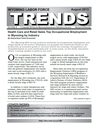Wyoming Lags Behind Surrounding States in Job Growth
Based on the most recent Unemployment Insurance (UI) covered wage and salary employment estimates, job growth in surrounding states like Colorado and Utah is outpacing job growth in Wyoming.
During the second half of 2012, the over-the-year percentage change in employment in Wyoming was lower than that of all surrounding states (Colorado, Idaho, Montana, Nebraska, South Dakota, and Utah) and the U.S. (see Figure 1). In December 2012, Utah (3.7%) and Colorado (2.7%) experienced the greatest increase in UI covered wage and salary employment compared to December 2011. States with large urban areas – such as Colorado and Utah – experienced the most growth, while more rural states experienced a slow, steady increase in employment.
Job growth in Wyoming, its neighboring states, and the U.S. from 2005 to 2012 is shown in Figure 2. The Great Recession lasted from December 2007 to June 2009 (NBER, 2010), and most states entered the recession several months before Wyoming. Before the Great Recession, Wyoming’s job growth was generally higher than its neighboring states. During 2008, high oil and natural gas prices spurred energy development in Wyoming, while holding back economic growth in the nation as a whole.
During the recession, a sharp drop in energy prices caused larger job losses in Wyoming than were seen in most neighboring states. Wyoming added jobs at a healthy pace early in the recovery, but in the second half of 2012 job growth slowed to very low levels. It is clear that Wyoming’s job growth has been lagging behind other states in the region.
Figure 3 shows Wyoming’s average annual unemployment rate and its employment-to-population ratio from 2005 to present. Before the recession, as employment was increasing, the unemployment rate fell to 2.8% in 2007. Then, as workers lost their jobs during the recession, the employment to population ratio fell (down from 70% to 65%) and the unemployment rate rose, hitting 7.0% in 2010.
In the recent recovery the unemployment rate has steadily decreased, while the employment to population ratio has remained largely flat. It seems that a large part of the decrease in the unemployment rate is related to people dropping out of the labor force, rather than returning to work.
One way to interpret the stagnant employment-to-population ratio is that employment and population are increasing at roughly the same rate, and therefore the ratio between the two is fairly constant. This is in direct contrast to the situation in 2005 and 2006, when employment increased faster than population, raising the employment-to-population ratio and driving the unemployment rate down.
References
National Bureau of Economic Research. (2010). Retrieved September 17, 2013, from http://www.nber.org/cycles/sept2010.html




